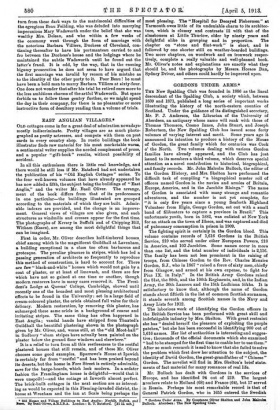EAST ANGLIAN VILLAGES.*
&MI6 Blr Basil Oliver,/..B.I.B.L. London : B. T. Batsford. 1 18. net.] Bulloch. Aberdeen The New Spalding Club. OLD cottages come in for a great deal of admiration nowadays, mostly indiscriminate. Pretty villages are as much photo- graphed as pretty actresses, and compete with them on post cards in every country shop. In rustic buildings the book
illustrator finds raw material for his most marketable wares, a sentimental writer supplies the needed complement of prose, and a popular " gift-book " results, without possibility of accident.
In all this enthusiasm there is little real knowledge, and there would be still less if Mr. Batsford had not undertaken the publication of his "Old English Cottages" series. To the four well-known volumes that have already appeared he has now added a fifth, the subject being the buildings of "East Anglia," and the writer Mr. Basil Oliver. The arrange. ment of the book differs from that of its predecessors in one particular—the buildings illustrated are grouped according to the materials of which they are built. Admir- able indexes are provided, and the change is an improve- ment. General views of villages are also given, and such structures as windmills and crosses appear for the first time. The photographs of Kersey in Suffolk and of Chipping Hill, Witham (Essex), are among the most delightful things that can be imagined.
First in order, Mr. Oliver describes half-timbered houses. chief among which is the magnificent Guildhall at Lavenham, a building exceptional in a class too often barbarous and grotesque. The peculiar pleasure in stripes, which has led a passing generation of architects so frequently to reproduce this method of construction, is hard to account for. There are few " black-and-white " houses which would not gain by a coat of plaster, or at least of limewash, and there are few which have not so gained at one time or another, though modern restorers have in many cases removed it. The Presi- dent's Lodge at Queens' College, Cambridge, showed until recently one of the broadest and most pleasing architectural effects to be found in the University: set in a large field of cream-coloured plaster, the oriels obtained full value for their delicacy. Modern restoration, by removing this plaster, has submerged these same oriels in a background of coarse and irritating stripes. The same thing has often happened in East Anglia ; vandal hands have stripped from Thaxted's Guildhall the beautiful plastering shown in the photograph given by Mr. Oliver, and, worse still, at the "old Moot-hall" in Sudbury "sham stripes have actually been painted on the plaster below the ground floor windows and elsewhere."
It is a relief to turn from all this restlessness to the restful plastered houses that still remain, and of these Mr. Oliver chooses some good examples. Sparrowe's House at Ipswich is certainly far from "restful "and has been praised beyond its deserts, but the house in Fore Street is entirely admirable, save for the barge-boards, which look modern. In a sedat,er fashion the Framlingbam house is delightful—would that it were unspoilt !—and the cottage at Ixworth almost perfect. The brick-built cottages in the next section are as interest- ing as would be expected in this Fleming-invaded district, the house at Wrexham and the inn at Scale being perhaps the most pleasing. The "Hospital for Decayed Fishermen" at Yarmouth owes little of its undeniable charm to its architec- ture, which is clumsy and contrasts ill with that of the almshouses at Little Thurlow, older by ninety years and delightful alike in grouping and in proportion. The chapter on "stone and flint-work" is short, and is followed by one shorter still on weather-boarded buildings. Two more chapters, on woodwork and on ironwork respec- tively, complete a really valuable and well-planned book. Mr. Oliver's notes and explanations are exactly what they should be, and the photographs by Messrs. Horace Dan, Sydney Driver, and others could hardly be improved upon.














































 Previous page
Previous page